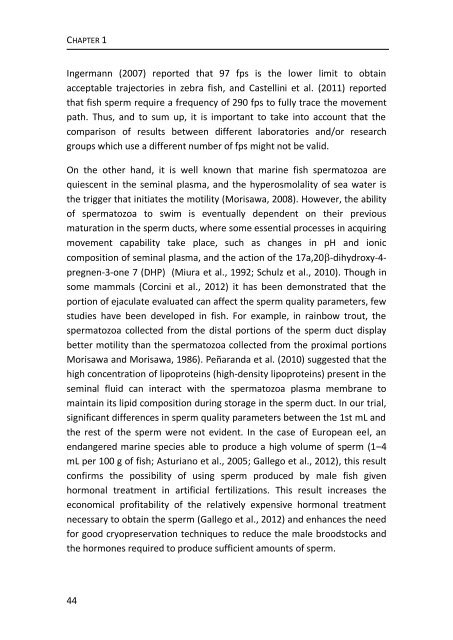chapter 3 - RiuNet
chapter 3 - RiuNet
chapter 3 - RiuNet
You also want an ePaper? Increase the reach of your titles
YUMPU automatically turns print PDFs into web optimized ePapers that Google loves.
CHAPTER 1<br />
Ingermann (2007) reported that 97 fps is the lower limit to obtain<br />
acceptable trajectories in zebra fish, and Castellini et al. (2011) reported<br />
that fish sperm require a frequency of 290 fps to fully trace the movement<br />
path. Thus, and to sum up, it is important to take into account that the<br />
comparison of results between different laboratories and/or research<br />
groups which use a different number of fps might not be valid.<br />
On the other hand, it is well known that marine fish spermatozoa are<br />
quiescent in the seminal plasma, and the hyperosmolality of sea water is<br />
the trigger that initiates the motility (Morisawa, 2008). However, the ability<br />
of spermatozoa to swim is eventually dependent on their previous<br />
maturation in the sperm ducts, where some essential processes in acquiring<br />
movement capability take place, such as changes in pH and ionic<br />
composition of seminal plasma, and the action of the 17a,20-dihydroxy-4-<br />
pregnen-3-one 7 (DHP) (Miura et al., 1992; Schulz et al., 2010). Though in<br />
some mammals (Corcini et al., 2012) it has been demonstrated that the<br />
portion of ejaculate evaluated can affect the sperm quality parameters, few<br />
studies have been developed in fish. For example, in rainbow trout, the<br />
spermatozoa collected from the distal portions of the sperm duct display<br />
better motility than the spermatozoa collected from the proximal portions<br />
Morisawa and Morisawa, 1986). Peñaranda et al. (2010) suggested that the<br />
high concentration of lipoproteins (high-density lipoproteins) present in the<br />
seminal fluid can interact with the spermatozoa plasma membrane to<br />
maintain its lipid composition during storage in the sperm duct. In our trial,<br />
significant differences in sperm quality parameters between the 1st mL and<br />
the rest of the sperm were not evident. In the case of European eel, an<br />
endangered marine species able to produce a high volume of sperm (1–4<br />
mL per 100 g of fish; Asturiano et al., 2005; Gallego et al., 2012), this result<br />
confirms the possibility of using sperm produced by male fish given<br />
hormonal treatment in artificial fertilizations. This result increases the<br />
economical profitability of the relatively expensive hormonal treatment<br />
necessary to obtain the sperm (Gallego et al., 2012) and enhances the need<br />
for good cryopreservation techniques to reduce the male broodstocks and<br />
the hormones required to produce sufficient amounts of sperm.<br />
44
















